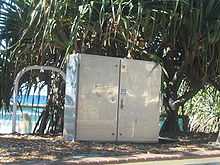Enclosure (electrical)


An electrical enclosure is a cabinet for electrical or electronic equipment to mount switches, knobs and displays and to prevent electrical shock to equipment users and protect the contents from the environment. The enclosure is the only part of the equipment which is seen by users; in many cases it is designed not only for its utilitarian requirements, but also to be pleasing to the eye. Regulations may dictate the features and performance of enclosures for electrical equipment in hazardous areas, such as petrochemical plants or coal mines.
Standards
United States
In the United States, the National Electrical Manufacturers Association (NEMA) publishes standards for the performance of various classes of electrical enclosures. The NEMA standards cover corrosion resistance, ability to protect from rain and submersion, etc.
International
For IEC member countries, standard IEC 60529 is classifying the ingress protection rating (IP Codes) of enclosures.
Materials
Electrical enclosures are usually made from rigid plastics, metals, particularly stainless steel, carbon steel, and aluminum, and natural or processed wood. There are typically three configurations for carbon steel used in electrical enclosure fabrication; hot rolled, cold rolled, and galvanized. They may be made for a specific purpose (e.g., the metal, plastic, or wooden box of a particular radio receiver) or to accommodate any equipment to which they are suited.
Terminology
Enclosures for some purposes have partially punched openings (knockouts) which can be removed to accommodate cables, connectors, or conduits. Where they are small and primarily intended to conceal electrical junctions from sight, or protect them from tampering, they are also known as junction boxes, street cabinets or technically as serving area interface.
Telecommunications
Telcordia Technologies has proposed generic requirements for electronic equipment cabinets. These requirements were developed with the input of United States North American service providers. GR-487, Generic Requirements for Electronic Equipment Cabinets, provides criteria for analyzing electronic equipment cabinets used in a variety of outside plant environments and applications, including wireless. It includes proposed functional design criteria, generic mechanical and environmental requirements, desired features, and performance tests.
Telecommunications huts are fully assembled or modular (i.e., built in place), transportable structures capable of housing an electronic communications system. These huts provide a controlled internal environment (i.e., Class 1 environment) for the communications equipment and occasional craftspersons. The huts are designed with locks, security, and alarms to discourage access by unauthorized persons.
These structures provide a convenient operational site for electronic equipment at a central distribution area or network node. Huts can be provided with a decorative facade to comply with local building requirements. The design of the facade and outer building structure (walls/roof) also serves several functional purposes, including the following:
- Provides decorative and aesthetics functions to help facilitate community acceptance and minimize the impacts from graffiti
- Provides physical protection to the structure and equipment against storm, hurricane, and other weather stresses
- Provides insulation against solar heating and helps to dissipate heat from the communications equipment inside the hut to the outside.
Hut facilities should be designed to allow the entry of telecommunications cables and local power supply into the building. A hut is differentiated from other electronic enclosures by the features of being entirely above ground.
Telecommunications huts are designed to withstand climate conditions existing throughout the USA including rain, snow, sleet, high winds, ice, and sand storms. Ambient temperatures ranging from -40°F (-40°C) to 115°F (46°C) can be encountered. Some locations may be prone to earthquakes or severe lightning storms.
GR-43, Issue 2, Generic Requirements for Telecommunications Huts, outlines the proposed specifications for Above Ground/Electronic Equipment Enclosures (AG/EEEs).
See also
- Bud Industries
- Fiber to the telecom enclosure
- NEMA enclosure types
- Rack unit
- Telco can
- Utility vault
References
External links
- NEMA website.
- NEMA definitions (from NEC webpage)
- IEC IP definitions, and a comparison of IEC<>NEMA definitions
- Information Website Relating to Outdoor Electrical Enclosures
- Types of Enclosures
- Metal Finishes for Electrical Enclosures